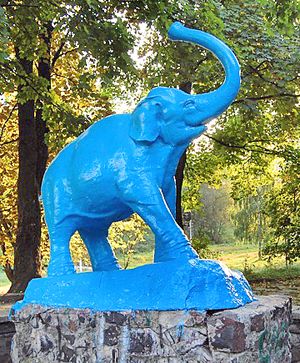The Lutsk elephant is a chameleon
The informal symbol of the city changes its color again. Where did this tradition come from, who likes to take walks here, and what did this exotic animal’s “home” look like before?
LUTSK – Last year, a project launched by the newly created utility company “Center for Tourist Information and Services” was very popular in Lutsk. It was called “Tour Guides on Vacation”: well-known local residents would take anyone interested on a tour around the ancient city of Lutsk – free of charge! The amateur guides included scholars, public servants, journalists, and artists who were expert in a certain area of local history. The tour “Informal Lutsk” (given by Serhii Martyniuk, frontman of the band Fiolet) proved to be especially popular. One of the most admired sites was an informal symbol of Lutsk, the sculpture of an elephant in the former Voroshylov Park, which now is reduced to a few shady alleys. But the little elephant is still there, attracting kids with guitars, amateurs of singing, or just anyone who seeks a quiet place to share the latest news. Interestingly, Lutsk has a tradition to regularly change the little elephant’s color. It has been gray, orange, golden, green, blue, and even pink, which brought forth a joke about it having changed its sexual orientation.
For a long time the sculpture has been painted by a certain citizen, whom the website Non-Format Lutsk has dubbed Romantic. Or at least this is how he would be referred to. Some people dropped litter around the sculpture, others cleaned the mess and washed away the autographs left by some foul-mouthed graffiti writers. But a few days ago the elephant changed color again, acquiring a bright orange hide. It was painted by some teen girls who like to take walks in this area. The passers-by would not believe that the painting jobs are done by the elephant’s fans and not the staff of the Palace of Youth (whose building is just meters away).
But few locals know that the park in this area dates back many decades ago, to the pre-war times. The Volyn Oblast State Archives have documents of 1934 which prove that the Polish administration (for back then Volhynia was part of Poland) had meant to create a luxurious recreation area for the entire voivodeship. This territory was called “governmental colony.” In fact, it was a village for the employees of the district land administration (whose building now houses the Oblast Local History Museum). On the slope of the tiny Sapalaivka River, which back then was flowing full between the green banks, the administration laid a park with alleys, the so-called “terrain Kur,” a health path. The peculiarity of the landscape, with winding serpentine paths along the slopes, made this area especially charming.
After the World War II the park was named after the Soviet General Kliment Voroshylov. Natalia Pushkar, curator of the Oblast Local History Museum and a resident since 1947, has very vivid memories of that park. She remembers the pompous, Soviet-style sculptures at the entrance: the Worker and the Peasant Woman. Of course, she remembers the elephant too, but there used to be a pug next to it, which later miraculously vanished. The park also had another attraction, a dance floor (a plain wooden box), very popular with the youth. This was next to another sculpture, the deer. The deer has survived, but its popularity cannot beat the elephant’s. The archives included a pre-war postcard, where the terrain Kur can be seen in all its original beauty.
In the 1950s a children’s railroad was built on one of the slopes of the park. Despite the usual problem (the lack of funding), the railroad has survived until our day. The park was subsequently renamed in honor of Young Railroad Workers or the Komsomol, but the new names never stuck, and the area has always been popularly referred to as Voroshylov Park, although few will know now who this Voroshylov was.
Of course, later much of the territory was taken by housing development, and a lot of trees and shrubs were destroyed. Goodness knows how the little elephant survived. But perhaps every city should have such a nice, informal symbol.
Author
Natalia MalimonNewspaper output №:
№77, (2012)





